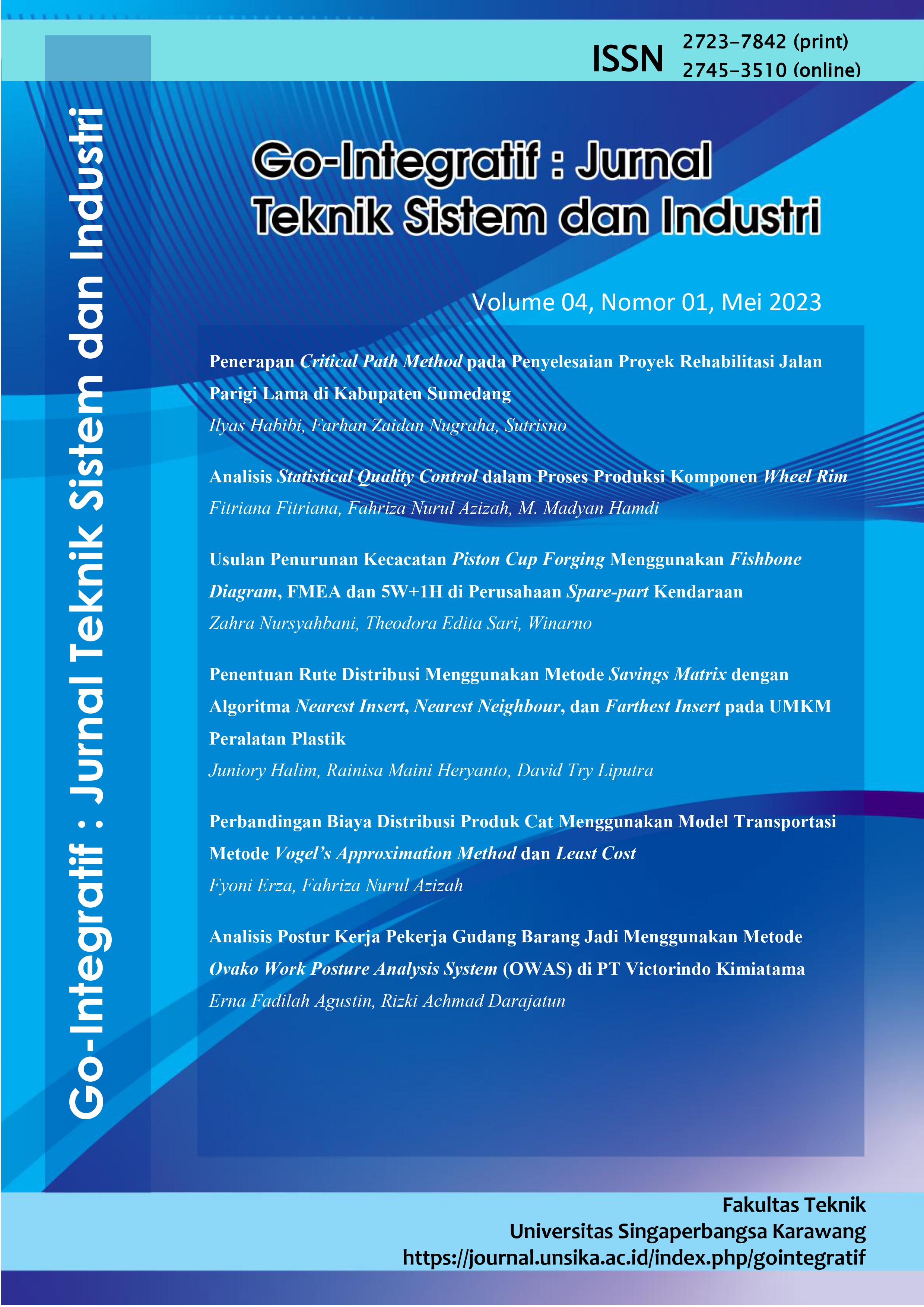Analisis Postur Kerja Pekerja Gudang Barang Jadi Menggunakan Metode Ovako Work Posture Analysis System (OWAS) di PT Victorindo Kimiatama
DOI:
https://doi.org/10.35261/gijtsi.v4i01.8843Abstract
PT Victorindo Kimiatama is a company engaged in the paint industry. Work activities in this company are dominantly carried out manually using human labor, one of which is in the work process in the finished goods warehouse. In manual material handling activities in the finished goods warehouse, workers often do work with bending, squatting, and rotating work posture and the process is carried out manually repeatedly with a load of up to 20 kg. So that it can pose a risk of musculoskeletal disorders. This study aims to analyze work posture finished goods warehouse workers using the Ovako Work Posture Analysis System method. Based on the results of the analysis it is known that there are four activities that are in category 3 or high category where the work conditions require renewal as soon as possible while one activity is in category 2 or medium category, which means there is a possibility of musculoskeletal risk. To minimize the emergence of musculoskeletal disorders, the suggested improvements are changes in movement or work position and designing supporting facilities that are in accordance with the worker’s body dimensions.
Downloads
References
O. Adiyanto, F. A. Prasetyo, and F. K. Ramadhani, “Manual Material Handling Pada Proses Pengangkatan Karung Menggunakan Pendekatan Biomekanika dan Fisiologi,” J. Penelit. Saintek, vol. 24, no. 1, pp. 32–38, 2019.
D. Pramestari, “Analisis Postur Tubuh Pekerja Menggunakan Metode Ovako Work Posture Analysis System (OWAS),” Ikraith-Teknologi, vol. 1, no. 2, pp. 22–29, 2017.
R. Patradhiani, Yasmin, and A. Prastiono, “Identifikasi dan Pengendalian Risiko Penyebab Penyakit Akibat Kerja ( PAK ) Pada Industri Tahu Pong Goreng Palembang,” Integr. J. Ilm. Tek. Ind., vol. 2, no. 5, pp. 41–48, 2019.
I. P. Tunang, W. T. Utama, and H. Ismunandar, “Gangguan Musculoskeletal Akibat Kerja: Epidemiologi, Faktor Risiko, Gejala Klinis, Tatalaksana dan Pencegahan,” Agromedicine, vol. 9, no. 2, pp. 109–115, 2022.
M. Joshi and V. Deshpande, “A Systematic Review of Comparative Studies on Ergonomic Assessment Techniques,” Int. J. Ind. Erg., vol. 74, no. 102865, 2019, doi: 10. 1016/j.ergon.2019. 102865.
W. Laila, “Kajian Perbaikan Postur Kerja dengan Metode OWAS (Ovako Working Posture Analysis System) (Studi Kasus di Pabrik Roti Cimpago Putih),” J. Sains dan Teknol., vol. 17, no. 2, pp. 138-146, 2017.
A. N. Bintang and S. K. Dewi, “Analisa Postur Kerja Menggunakan Metode OWAS dan RULA,” J. Tek. Ind., vol. 18, no. 01, pp. 43–54, 2017.
N. P. Pamungkas, and K. Erliana, “Analisis Postur Tubuh Pekerja Industri Perak di UMKM Silver 999 Menggunakan Metode RULA (Rapid Upper Limb Assessment),” J. Ind., vol. 03, no. 02, pp. 45–54, 2021.
L. Fitria, N. J. Majid, and A. Sokhibi, “Analisis Postur Kerja Proses Pengukiran Kayu UKM Andi Mebel Jepara dengan Menggunakan Metode REBA,” Jointech UMK, vol. 1, no. 1, pp. 25–35, 2020.
A. H. Pradini, D. R. Lucitasari, and G. M. Putro, “Perbaikan Sistem Kerja dengan Pendekatan Macroergonomic Analysis and Design (MEAD) untuk Meningkatkan Produktifitas Pekerja (Studi Kasus di UD Majid Jaya, Sarang, Rembang, Jawa Tengah),” J. Optimasi Sist. Ind., vol. 12, no. 1, pp. 36–47, 2019.
M. Imron, “Analisis Tingkat Ergonomi Postur Kerja Karyawan di Laboratorium KCP PT. Steelindo Wahana Perkasa dengan Metode Rapid Upper Limb Assessment (RULA), Rapid Entire Body Assessment (REBA) dan Ovako Working Posture Analysis System (OWAS),” JITMI, vol. 2, no. 2, pp. 147–151, 2019.
S. Fikri and A. E. Nugraha, “Usulan Perancangan Alat Bantu Perpindahan Barang yang Ergonomis dari Stasiun Kerja Mesin Shearing ke Mesin Bending di PT . XYZ,” Serambi Eng., vol. VII, no. 4, pp. 3933–3940, 2022.
HSE, “Work-related Musculoskeletal Disorders (WRMSDs) Statistics.” Health and Safety Executive, 2010.
R. Ginanjar, A. Fathimah, and R. Aulia, “Analisis Risiko Ergonomi Terhadap Keluhan Musculoskeletal Disorders (MSDs) pada Pekerja Konveksi di Kelurahan Kebon Pedes Kota Bogor Tahun 2018,” J. Promotor, vol. 1, no. 2, pp. 124–129, 2018.
M. R. Randany and I. Masrofah, “Analisis Sistem Kerja dan Postur Tubuh Pekerja Karyawan Bagian Gudang Penyimpanan Beras Menggunakan Metode OWAS,” Semin. dan Konf. Nas., pp. 1–10, 2021.
M. K. Faudy and S. Sukanta, “Analisis Ergonomi Menggunakan Metode REBA Terhadap Postur Pekerja pada Bagian Penyortiran di Perusahaan Bata Ringan,” Go-Integratif J. Tek. Sist. dan Ind., vol. 03, no. 01, pp. 47–58, 2022.
N. S. Suharto, and A. Susanti, “Perbaikan Postur Kerja untuk Mengurangi Keluhan Musculoskeletal dengan Menggunakan Ovako Work Analysis System (OWAS) Pada CV. Java Comaco Prima,” J. Online Tek. Ind., vol. 3, no. 2, 2014.
D. K. Baroroh, “Perbandingan Sensitivitas Metode REBA, OWAS, dan QEC dalam Evaluasi Tingkat Risiko Postur Kerja (Studi Kasus di WL Aluminium Giwangan),” Semin. Nas. Tek. Ind. Univ. Gadjah Mada 2017, pp. 93–102, 2017.
K. Wijaya, “Identifikasi Risiko Ergonomi dengan Metode Nordic Body Map Terhadap Pekerja Konveksi Sablon Baju,” Semin. dan Konf. Nas. IDEC, pp. B08.1-B08.9, Mei 2019.
W. E. Cahyanto and A. E. Nugraha, “Analisis Postur Pekerja Menggunakan Metode Rapid Upper Limb Assessment pada UMKM Kerupuk Setuju,” Serambi Eng., vol. VIII, no. 1, pp. 4381–4387, 2023.
A. Setiorini, “OWAS ( Ovako Work Analysis System ),” JK Unila, vol. 4, no. 2, pp. 197–204, 2020.
Downloads
Published
How to Cite
Issue
Section
License
Copyright (c) 2023 Erna Fadilah Agustin, Rizki Achmad Darajatun

This work is licensed under a Creative Commons Attribution-NonCommercial-ShareAlike 4.0 International License.



